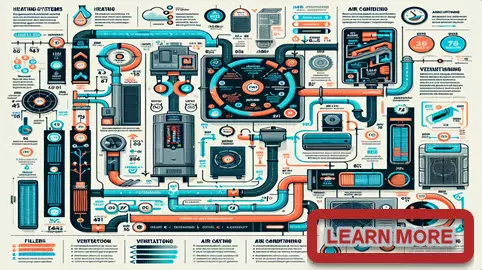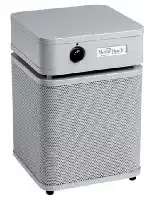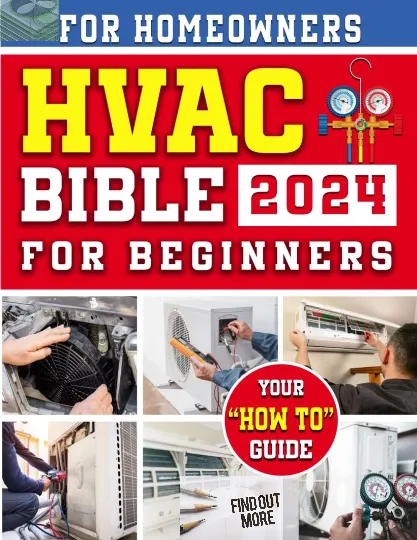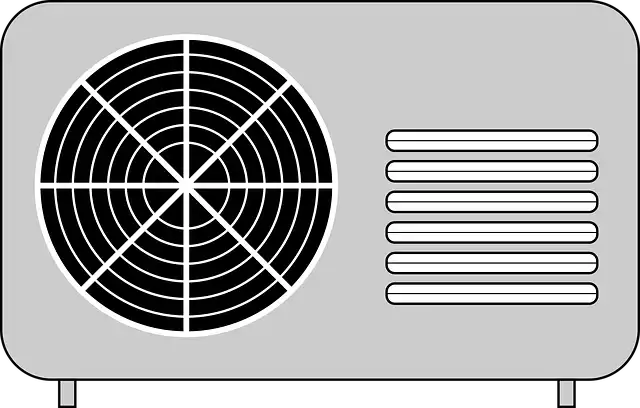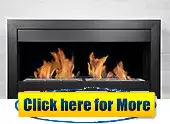Everything You Need to Know about HVAC
As seasons shift, the demand for climate control in our homes and workplaces grows, making HVAC systems an essential part of modern life
HVAC stands for Heating, Ventilation, and Air Conditioning, and it’s all about a mix of technologies that keep our indoor air fresh and comfy
Understanding how these systems work can help homeowners and businesses make smart choices about their climate control investments
Let’s dive in—it’s key to know the difference between HVAC systems and standalone air conditioners
HVAC systems offer a broader range and benefits through integration
Whether it’s the core parts like refrigerants and blower motors or the clever smart features that boost energy efficiency, everything helps in making these systems work better
Whether you’re thinking about traditional central cooling and heating or exploring new geothermal options, understanding these differences is important for finding the right fit for your needs
This article will walk you through all the must-know details about HVAC systems, from basic definitions to tips on extending system life
We’ll look at different types of HVAC systems, the perks of smart technologies, and why regular maintenance is key
By examining cost factors and installation considerations, you’ll gain the insight you need to choose the best system for your unique space
Table of Contents Everything You Need to Know about HVAC
What is HVAC?
HVAC stands for heating, ventilation, and air conditioning, which are essential systems responsible for regulating temperature, airflow, and air quality within a building
These systems are crucial for maintaining comfort and ensuring the health and well-being of occupants by providing consistent temperature control and fresh air circulation
An HVAC system typically includes components like a furnace, air conditioner, and related duct-work that work together to keep indoor environments at optimal comfort levels year-round
In addition to controlling temperature, HVAC systems filter the air and help maintain indoor air quality by minimizing pollutants and allergens
Definition and Basic Concepts
HVAC systems form the backbone of indoor climate control, ensuring comfort and safety in living and working environments
The system comprises heating devices, cooling equipment like air conditioners, and an integrated network of ducts and vents that facilitate air circulation
Ventilation plays a crucial role by introducing fresh air into closed spaces and filtering it to remove contaminants
HVAC systems are versatile and can be tailored to specific needs, whether as compact units, portable solutions, or complex networks that include outdoor units
These systems not only manage temperature but also help control humidity and improve indoor air quality
Difference between HVAC and Air Conditioning
While HVAC systems provide comprehensive indoor climate control, featuring heating, ventilation, and air-conditioning, air-conditioning systems focus solely on cooling
Air conditioning is fundamentally a subset of HVAC, as it handles only one aspect of the broader HVAC functionalities
In contrast, a full HVAC system includes a heating component, such as a furnace or heat pumps, allowing it to regulate both hot and cold temperatures throughout the year
Moreover, the ventilation element of HVAC systems ensures that indoor air remains clean and free from pollutants by filtering and recirculating it
This distinction highlights the broader scope of HVAC systems in managing indoor environments compared to air conditioning systems, which are specifically engineered for cooling purposes only
Core Components of HVAC Systems
An HVAC system, short for Heating, Ventilation, and Air Conditioning, is crucial for maintaining comfort in residential and commercial spaces
This system, often referred to as a split system or home comfort system, comprises several key components
At its core, it features an indoor unit, like a furnace or air handler, and an outdoor unit, such as an air conditioner or heat pump
Together, these units work to control indoor temperature, air circulation, and air quality throughout the building
Ductwork is a critical element that distributes air from these units into various rooms, ensuring even temperature distribution
Complementing these components is a thermostat, which acts as the system’s brain, maintaining the desired indoor climate
In addition, comprehensive HVAC systems are equipped with indoor air quality components like air filters and humidifiers, enhancing comfort by improving air purity and humidity level
Understanding these core components helps in appreciating the sophistication and efficiency of modern HVAC systems
Refrigerant
The refrigerant is a vital working fluid in HVAC systems, central to their air conditioning function
It plays the crucial role of absorbing unwanted heat to provide cool air during the warmer months
In addition, when the HVAC system operates in reverse, typically during the winter, the refrigerant helps shift warmth from the outdoor air into the home
Without refrigerant, air conditioning and heat pump components of an HVAC unit would be inoperative, unable to fulfill their heating and cooling functions efficiently
This fluid’s ability to shift states—absorbing and releasing heat—is pivotal to regulating indoor climate across various seasons
Air Handlers
Air handlers are integral to an HVAC system’s ability to distribute air throughout a home
These units are primarily responsible for circulating both warm and cool air, ensuring consistent temperatures in every room
While they don’t generate heat or coolness, air handlers work in tandem with heat pumps or air conditioning units to move air through ductwork
This circulation is essential for maintaining optimal indoor climate conditions
Importantly, air handlers also contribute to indoor air quality
They facilitate the movement of clean, filtered air, which improves air quality and reduces allergens in the home
Their role in both air circulation and purification makes them a vital component of any central HVAC system
Blower Motors
Blower motors are the powerhouse behind the HVAC system’s capacity to distribute conditioned air
These motors drive the fans that circulate hot or chilled air through the ductwork to various rooms in a home
Blower motors kick in when the room’s air reaches the temperature set by the thermostat, ensuring efficient heating or cooling
In both residential and commercial HVAC systems, blower motors are essential for delivering air to the desired spaces
Regular inspection and maintenance of blower motors are crucial, as they help prevent breakdowns and costly repairs
Given their role in overall system efficiency, blower motors demand special attention from HVAC technicians
Understanding how they operate can significantly impact the energy efficiency and longevity of the entire HVAC system
Types of HVAC Systems
Heating, ventilation, and air conditioning (HVAC) systems are integral to maintaining a comfortable indoor climate regardless of the season
These systems can be configured in various ways to suit specific building requirements and local climate conditions
Central to a typical HVAC setup is its ability to provide both heating and cooling, making it indispensable in both residential and commercial settings
Different types of HVAC systems, such as split, packaged, ductless, and hybrid systems, each offer unique advantages tailored to diverse needs
Understanding these systems allows you to make informed decisions about which type best suits your living or working environment
Central Cooling and Heating Split Systems
Central cooling and heating split systems are among the most commonly used HVAC solutions in many U
S
homes, providing comprehensive climate control through a two-part design
These systems consist of an indoor unit containing the furnace and evaporator coils, and an outdoor unit where the compressor and condenser are located
Widely recognized as central air systems, they are favored for their efficiency in heating and cooling entire homes
However, they require duct-work installation, which can make the initial costs higher compared to other systems
Known for their energy efficiency, these systems often come with high SEER ratings, establishing them as a preferred choice for homeowners seeking to reduce energy consumption while maintaining comfort
Ductless Mini-Splits
Ductless mini-splits offer a versatile and efficient solution for spaces lacking traditional ductwork
This system works by connecting an outdoor condenser/compressor unit to one or more indoor units through electrical wiring and refrigerant tubing
Each indoor unit can be individually controlled to maintain different temperatures in separate rooms, offering customizable comfort for inhabitants
While these units cannot simultaneously heat and cool, their high efficiency can help minimize energy consumption and lead to savings on electricity bills over time
Complimentary to their efficiency, ductless mini-splits are straightforward to install compared to their ducted counterparts and eliminate energy losses typically associated with duct systems
Geothermal Systems
Geothermal systems provide an eco-friendly alternative to conventional HVAC solutions by harnessing the earth’s stable underground temperatures
Through a series of underground pipes, these systems exchange heat to offer efficient heating and cooling
While the upfront costs of geothermal systems are higher than standard heat pumps, they promise significant long-term energy savings and reduced electricity use during peak demand times
These systems are particularly appealing to environmentally-conscious homeowners as they do not rely on fossil fuels, thus reducing carbon footprints
An adequate amount of yard space is necessary to install the underground pipes that facilitate geothermal heating and cooling, making it a viable option for those with larger properties
Smart HVAC Systems
Smart HVAC systems represent the future of efficient and convenient heating and cooling solutions
These advanced systems connect to the internet, allowing homeowners to control their air conditioning units remotely using a smartphone
This capability means you can manage your home’s temperature from virtually anywhere, ensuring optimal comfort and energy usage
The integration extends further as smart HVAC systems can harmonize with smart home platforms such as Google Home and Amazon Alexa
This interoperability allows users to operate their systems seamlessly along with other smart devices
While the initial investment may be higher than traditional HVAC systems, particularly with prices ranging from $300 to $3,000 or more, the long-term benefits and conveniences often outweigh these costs
Features and Benefits
Smart HVAC systems bring several distinct features and benefits to the table, revolutionizing traditional home temperature management
The ability to control your HVAC system remotely via smartphone is a game-changer, allowing adjustments to be made no matter your location
This level of control ensures that your home is always at the perfect temperature when you arrive
Moreover, the ability to integrate with other smart home technologies means you can create a more cohesive living environment, as these systems can monitor and optimize air conditioning usage without manual intervention
One of the most significant advantages of utilizing a smart HVAC unit is the potential for energy savings
By controlling when and how your HVAC system operates, you can minimize energy wastage and potentially lower your electricity bills over time
These systems can run more efficiently, requiring less active running time to maintain desired comfort levels
Additionally, smart thermostats within these systems allow users to create temperature schedules and access remote diagnostics, further enhancing convenience and efficiency
By investing in smart HVAC technology, you are not only enhancing comfort but also making a conscious effort towards energy conservation
Energy Efficiency and Cost Savings
Investing in a smart HVAC system comes with significant energy efficiency benefits and cost savings over time, making it a financially sound decision
Newer models are designed to provide consistent temperature control, better air filtration, and quieter operation, all of which improve indoor comfort and air quality
These systems are often so efficient that they can slowly pay back their cost through savings on energy bills
Homeowners can save up to $576 annually on energy expenses by upgrading to an energy-efficient HVAC system
Moreover, financial incentives such as government and local utility rebates, along with potential federal tax credits, can make the transition to an energy-efficient HVAC system more affordable
As heating and cooling account for over 50% of a home’s energy use, improving system efficiency is crucial for reducing energy consumption
By choosing energy-efficient HVAC equipment, homeowners reduce their long-term running costs, offsetting the initial installation expenditure
Therefore, transitioning to a modern, efficient HVAC system is not just an upgrade but a strategic investment towards lower total ownership costs and a more sustainable lifestyle
Maintenance of HVAC Systems
Maintaining your HVAC system is crucial for ensuring its efficient operation and longevity
Regular maintenance tasks, such as replacing air filters, inspecting refrigerant lines, and cleaning coils, can significantly enhance the system’s performance
Not only does this upkeep prevent unexpected, costly breakdowns, but it also maximizes energy efficiency, reducing your energy bills over time
Given that HVAC systems account for 39% of energy usage in US commercial buildings, regular maintenance is not just a recommendation but a necessity
When carried out effectively, routine servicing can extend the life of your HVAC unit up to 15 years
Addressing issues like clogged drains or dirty evaporator coils can ensure your system runs smoothly, maintaining optimal indoor temperature and air quality
Importance of Regular Maintenance
The benefits of regular HVAC maintenance are numerous, starting with improved energy efficiency
A well-maintained system requires less effort to maintain the desired indoor temperature, which means reduced energy consumption and lower energy bills
Moreover, this also ensures the unit operates at peak performance, enhancing overall comfort levels within the home
A key advantage is the extension of the system’s life expectancy; consistent maintenance can prevent minor issues from developing into major problems, potentially making your HVAC system last up to 15 years
Additionally, a properly maintained system contributes to better indoor air quality, reducing pollutants and allergens that can impact health
Thus, regular HVAC maintenance not only ensures comfort and efficiency but also supports a healthier living environment
Signs of Performance Issues
Spotting early signs of HVAC performance issues can save you from expensive repairs down the line
Strange noises such as banging, rattling, or whistling often point to mechanical issues or loose parts within the system
Another common sign is uneven temperatures across different rooms, indicating potential airflow problems or zoning issues
If you notice a sudden increase in your energy bills without any change in usage habits, it could be a signal that the HVAC system is not operating efficiently
Additionally, strange odors, poor indoor air quality, or erratic temperatures may suggest issues with the system that need attention
Recognizing these signs early can lead to timely maintenance or repairs, ensuring your HVAC system remains reliable and efficient
Tips for Prolonging System Life Expectancy
Prolonging the life expectancy of your HVAC system hinges on regular maintenance and proper care
Ensuring regular servicing, at least once a year, can reduce the likelihood of costly breakdowns by up to 95%
It’s crucial to maintain the cleanliness of air filters, as clogged filters can hamper the system’s efficiency and contribute to wear and tear
When installing an HVAC system, ensuring proper installation techniques can minimize future issues
Additionally, coastal areas pose a particular risk for HVAC systems due to corrosion from salt exposure, necessitating more frequent maintenance checks
By prioritizing these maintenance tasks, you not only extend the system’s lifespan but also maintain optimal efficiency and performance
Decision-Making for New Installations or Replacements
When deciding whether to install a new HVAC system or replace an existing one, several critical factors come into play
One of the primary considerations is energy efficiency
Modern HVAC systems boast high SEER (Seasonal Energy Efficiency Ratio) ratings and AFUE (Annual Fuel Utilization Efficiency) for heating, ensuring both superior performance and cost savings
However, making the right system choice is not just about efficiency ratings
System sizing is equally crucial, as a system that’s too large or too small can lead to accelerated wear and increased energy costs
Installation costs are another key consideration, especially when additional elements like new duct-work are required
This cost can soar when working with historic homes that demand careful retrofitting
Despite the potentially higher initial outlay for energy-efficient systems, rebates, and incentives from governments and utilities can substantially reduce this expense, making energy-efficient options more accessible
Factors Influencing Cost
The installation of a new HVAC system can have a significant impact on your budget, and several factors contribute to the overall cost
Installing duct-work alone can add between $2,000 and $3,000 to the total project cost
The difficulty of installation also affects price, with challenging environments like cramped attics or historic homes potentially driving up labor expenses
Enhanced features in newer, energy-efficient systems, such as improved air filtration and reliable temperature control, might increase upfront costs
Nevertheless, these are frequently balanced by incentives or an increase in your property’s value
Moreover, there’s a spectrum of costs associated with different air conditioning options
For instance, while window air conditioners range from $150 to $1,000, a ductless mini-split system averages around $3,500, and central air conditioning can cost anywhere from $3,811 to $7,476
The choice of brand, system sizing, location-specific pricing, and any additional features like air cleaners or integrated humidifiers further influence the total expense
Considerations for Home Specifications
When evaluating HVAC systems for your home, it’s essential to take into account specific home characteristics that can guide your decision
Residential HVAC systems are crafted with a focus on comfort and quiet functioning, making them particularly well-suited for living areas where noise reduction is a priority
The systems utilize fundamental components such as air conditioners or heat pumps, complemented by furnaces or air handlers and duct-work, to efficiently manage indoor climates
Furthermore, the value of a well-maintained HVAC system becomes evident as it enhances indoor air quality and maintains optimal humidity levels, ensuring health and comfort throughout the year
The core aim of heating, ventilation, and air conditioning is to maintain a fresh indoor atmosphere by effectively eliminating pollutants, dust, and allergens
Depending on your home setup, options like air-source heat pumps and ductless mini-splits stand as viable parts of a comprehensive HVAC strategy
Tips for Choosing the Right System
Selecting the right HVAC system demands a careful evaluation of several factors, such as the size and age of your house, its architectural design, and the surrounding climate
The condition of any existing duct-work is also vital in making an informed choice
Engaging a certified HVAC dealer can provide you with expert guidance tailored to your home’s unique needs
Investing in certain brands like Lennox ensures access to some of the quietest and most efficient systems available, enhancing both comfort and energy savings
A professional HVAC service can assist in designing a system that aligns with your preferences and local climate conditions
Before making a final commitment, it’s advisable to explore the variety of systems on the market to ensure you’re making the most beneficial investment for your home’s specific requirements
This comprehensive approach not only aids in achieving long-term savings but also enhances overall residential comfort and air quality

